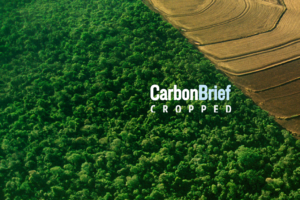Welcome to Carbon Brief’s China Briefing.
China Briefing handpicks and explains the most important climate and energy stories from China over the past fortnight. Subscribe for free here.
Key developments
China fails to submit 2035 climate pledge
MISSED DEADLINE: China, along with 181 other countries, missed the deadline to submit its next “nationally determined contribution” (NDC), a key climate pledge to the UN that “acts as an accountability measure to ensure countries are taking climate change seriously”, Agence France-Presse reported. It added that, according to unnamed analysts, China is “expected to release its much-anticipated NDC in the second half of 2025”. Chinese foreign ministry spokesperson Guo Jiakun said China will follow its “own path, approach and pace to fulfil the ‘dual-carbon’ targets to which it has committed”, in comments covered by industry newspaper China Energy Net. According to the outlet, he added that the country has “always been a doer and an activist in addressing climate change” and will submit its NDC “at the proper time”.
WAIT AND SEE: According to the Guardian, China and other countries would prefer “putting off the publication of [NDCs]” until the early disruption caused by the second Trump administration subsides. In a statement, Yao Zhe, global policy advisor at Greenpeace East Asia, said that “China’s submission will happen later this year”, adding that China must set “ambitious” goals that “include both a strong commitment to renewables and clear measures to move away from coal”. Li Shuo, director of the Asia Society Policy Institute’s China climate hub, told Eco-Business that China’s desire to wait and see how the US will “reshape” global political and economic orders is “natural”, adding that “the hope is that more time will lead to better quality”. China was not alone in missing the NDC deadline, with countries accounting for 83% of global emissions falling short, according to Carbon Brief analysis.
-
Sign up to Carbon Brief’s free “China Briefing” email newsletter. All you need to know about the latest developments relating to China and climate change. Sent to your inbox every Thursday.
OIL ‘SLOWDOWN’: Elsewhere, a new report by the International Energy Agency (IEA) and covered by Bloomberg found that “China’s use of the three most important fuel products – gasoline, jet/kerosene and gasoil – declined slightly to 8.1m barrels a day in 2024”, marking an “unprecedented” slowdown. The outlet said the shift, attributed by the IEA to the uptake of electric vehicles and economic changes, could drive a plateau in the country’s overall oil demand this decade.
Clean-energy technology’s economic contribution rises
GROWTH DRIVER: Clean-energy technologies contributed 13.6tn yuan ($1.9tn) to the Chinese economy in 2024, comprising more than 10% of GDP for the first time, new research for Carbon Brief has found. Much of the rise was driven by the value of goods and services, which grew 21% compared to 2023, as opposed to investment, which was up 7% year-on-year, the analysis added.
‘NEW THREE’ LEAD: The “new three” industries accounted for most of this growth. Electric vehicles and vehicle batteries “were the largest contributors to China’s clean-energy economy in 2024”, comprising almost 40% of its value. The next largest category was solar power, which generated 2.8tn yuan ($390bn).

GAINING IMPORTANCE: Clean-energy technologies contributed more to the economy in 2024 than real-estate sales (9.6tn yuan, $1.3tn) and agriculture (9.1tn yuan, $1.3tn), the analysis said. It added that China’s investment in clean energy alone is “close to the global total [investment] put into fossil fuels in 2024”. Investment is set to grow in 2025, due in part to a “race to complete” large-scale projects before the end of the five-year plan period (2021-2025). The importance of clean energy to supporting economic growth now “creates incentives for policymakers to ensure the economic health of the sector”, the analysis added.
Wang Yi’s European tour
STRATEGIC DIALOGUE: Chinese foreign minister Wang Yi met with UK prime minister Keir Starmer in his first official visit to the country in a decade, Reuters said, adding that the two “discussed strengthening cooperation in dealing with climate change, artificial intelligence and clean energy”. Wang also held talks with his UK counterpart David Lammy, English-language state broadcaster CGTN said, in which the two foreign ministers “emphasised the importance of advancing the full and effective implementation of the Paris Agreement and supporting both countries’ green transitions”.
WARM WELCOME?: Bloomberg covered development of China’s “impending listing of an inaugural sovereign green bond in London”, quoting Nneka Chike-Obi, head of Asia-Pacific ESG ratings and research at Sustainable Fitch, saying the move would allow China “to get…feedback from international investors” during roadshows and deliver assurances about its climate plans. China has released a “framework” for its green sovereign bonds, the Communist party-affiliated People’s Daily announced, adding the document will be used as the “basis for issuing Chinese green sovereign bonds overseas”. Meanwhile, the UK’s security services are reviewing whether “Chinese technology such as solar panels or industrial batteries could pose potential future security threats”, the Financial Times reported.
SECURITY TALKS: Wang also travelled to Germany, where he said at the Munich Security Conference that China has “acted earnestly on the Paris Agreement”, adding countries “should tackle common challenges in solidarity, rather than resort to bloc confrontation”, according to a transcript published by the Ministry of Foreign Affairs. State news agency Xinhua reported that climate change was also raised in Wang’s meetings with representatives of the EU, France and Germany on the sidelines of the conference.
MEDIA VOICES: Meanwhile, Chinese media issued a number of editorials and commentaries emphasising the need for China-Europe cooperation. One editorial in state-run newspaper China Daily noted “it is good to see both [the UK and China] oppose decoupling and…promote a nondiscriminatory and open business environment”. Another China Daily editorial said “collaboration on climate change…has borne fruit through joint initiatives such as the China-EU Partnership on Climate Change”. Meanwhile, the state-supporting news outlet Global Times published an editorial arguing “there are broad common interests between China and the EU in maintaining a multilateral framework” to address issues such as climate change. The Global Times also published a commentary under the byline “GT Voice” arguing that there is a “pressing need for the rest of the world, particularly China and the EU, to strengthen cooperation on green development”.
New energy storage plan
STORAGE STRENGTH: China issued a plan to strengthen its energy storage sector, aiming to develop more “leading” manufacturers, improve “innovation” and increase the sector’s “overall competitiveness” by 2027, Xinhua reported. The policy will also “support research into emerging technologies”, such as alternative battery compositions, compressed air and hydrogen energy storage, the Hong Kong-based South China Morning Post said. Chinese news outlet Jiemian said the policy nevertheless warned against “blind investment and disorderly development”. Critical minerals were also covered, according to Reuters, with the government pledging to “strengthen support for exploring domestic mineral resources including lithium, cobalt and nickel” and “strengthen foreign investment and cooperation” towards overseas mineral exploration.
TIGHTENING CONTROL: Meanwhile, China also issued draft regulations which, if approved, would “tighten [its] control” over its rare-earth resources, Reuters reported, such as through “quotas for mining, smelting and separating” the minerals. Another Reuters investigation found that at least one Chinese company is following a draft proposal by the commerce ministry to restrict exports of certain technologies used to process lithium. The development, according to the Financial Times, is part of a broader move to “keep critical knowhow within [China’s] borders as trade tensions with the US and Europe escalate”, adding that the country has also “made it more difficult for some engineers and equipment to leave the country”. Environment NGO Transport & Environment has warned that Europe must develop a “regulatory framework for knowledge sharing” or else risk becoming “an assembly plant” for Chinese battery makers, another Financial Times report said. Elsewhere, the People’s Daily said China’s wind turbine exports rose 70% year-on-year in 2024, with solar and lithium battery exports showing a “strong performance”.
Spotlight
How China’s renewable pricing reforms will affect its climate goals
China’s solar and windfarms would no longer be guaranteed sales at a fixed price linked to coal benchmarks, under a new policy released by the central government.
Under the new “sustainable new energy pricing mechanism”, new wind and solar schemes would be paid a fixed price determined at auction.
In this issue, Carbon Brief examines how the new guidelines will affect China’s energy transition.
More ‘market-oriented’
From 2026, China has announced that the price of electricity generated from solar and wind schemes will be determined according to competitive auctions.
This will replace the existing fixed rates solar and wind received for their power, which was pegged to benchmarks for coal-fired power, with the new mechanism likely making prices for renewables much cheaper than coal.
The new system resembles the two-way “contract for difference” (CfD) mechanism used in the UK and elsewhere.
This setup would allow developers to have “reasonable and stable expectations” for revenue, supporting a “healthy” industry and China’s energy transition, a government Q&A said.
Despite some reporting to the contrary, the move does not constitute a rollback of subsidies for renewables. Grid operators have paid wind and solar power the same price as for coal-fired power since 2021.
The policy also cancels mandatory energy storage requirements for new wind and solar projects, which will significantly impact demand for energy storage.
Bringing prices up to date
The change to the rules has been attributed to the sharp reduction in the cost of building new solar and windfarms.
“The coal-fired grid benchmark rate was last updated in 2017 and actually has no relationship to the generation cost of renewables,” David Fishman, senior manager at energy consultancy Lantau Group, told Carbon Brief, adding it was effectively “arbitrary”.
The government Q&A argued that renewable energy schemes operating on a fixed tariff “cannot fully reflect market supply and demand” and do not “fairly [distribute] responsibility for power system flexibility”.
No pain, no gain
The exact impact that this will have on renewable developers will depend on the implementing rules adopted by local governments, according to Lauri Myllyvirta, lead analyst at the Centre for Research on Energy and Clean Air.
In the short-term, these companies will be hit by the loss of the guaranteed demand and the need to adapt to low prices and fierce competition, Fishman told Carbon Brief.
Companies will also need to develop stronger marketing and sales capabilities, and focus on “high-efficiency” and “large-capacity” technologies, said Wang Jihong, senior counsel at law firm Zhong Lun.
This may impact China’s growing distributed solar and wind sector. Distributed projects are much more likely to be run by smaller companies who may not have the resources to adapt to the new mechanism, according to Fishman, which could cause opportunities for distributed energy to “dry up”.
At the same time, the new policy may also force renewable energy power companies to innovate – both in terms of technology, and of business models and management practices, Dr Muyi Yang, senior energy analyst for Asia at the thinktank Ember, told Carbon Brief.
Stronger in the long-term?
The new pricing system may nevertheless give wind and solar the advantage in the long-term. Reform of the power market has long been seen as crucial to increasing uptake of renewables.
Myllyvirta wrote that wind and solar, as the “most affordable” sources of power, should be able to “hold their own in competition if the rules are set right”.
Yang told Carbon Brief that the pressure of being subjected to the market could make low-carbon energy “more competitive” and “help reduce inefficient investment”, which will be a “critical factor for the long-term transition of China’s energy sector”.
But local governments would need to take steps to maintain investor confidence in the face of low prices, Fishman said. For example, significantly raising provincial renewable consumption targets could provide a strong demand signal, showing wind and solar developers that there is still a “way to make money” through increased volume.
If the government “gets the numbers just a little bit wrong”, he added, the amount of new wind and solar being added to the grid “will drop off a cliff”.
At the same time, coal-fired power plants are continuing to receive policy and financial support, in the form of guaranteed demand from long-term contracts and compensation to keep excess capacity online.
China has ramped up construction of new coal plants, with almost 100 gigawatts of new capacity expected to come online in the next few years.
If coal plants are not also exposed to competition, Myllyvirta argued, then renewables may be “crowded out from the power market”.
Fishman was more sanguine, telling Carbon Brief that the new policy may give coal plants “a little bit of a boost” in the short-term, but that China’s carbon peaking goal sets a hard deadline for reducing their role in the power system.
He added that the real competition for coal plants are other coal plants, as only the “newest, the most efficient [and] the super-critical” plants will have a future as China moves towards carbon neutrality.
A full-length version of the article is available on the Carbon Brief website.
Watch, read, listen
FARMERS PROTEST: Current affairs news outlet Sixth Tone looked at how China is reversing its “zero-tolerance stance on crop burning” in the face of backlash from farmers.
PROSPECTS FOR DIPLOMACY: Laurence Tubiana, head of the European Climate Foundation [which funds Carbon Brief] and one of the architects of the Paris Agreement, gave a lecture at the University of Oxford on her outlook for climate diplomacy and China’s role within it.
CLIMATE NATIONALISM: Environmental Politics Journal interviewed the authors of a new study on how China uses “populist narratives” in propaganda to “mitigate the political costs” of its climate policies.
HYDROPOWER HISTORY: The New Books in Environmental Studies podcast discussed the history of hydropower development in China in the early-to-mid 1900s.
Captured

China began building 94.5 gigawatts (GW) of new coal-power capacity and resumed 3.3GW of suspended projects in 2024, according to new research by energy thinktanks the Centre for Research on Energy and Clean Air (CREA) and Global Energy Monitor (GEM) covered by Carbon Brief. This burst, spurred on mostly by investments from the coal mining industry, marks the highest level of new construction in the past 10 years, the report added.
New science
Elderly vulnerability to temperature-related mortality risks in China
Science Advances
Intensity and duration are the most important factors to consider when assessing the impact of extreme heat on mortality risk in elderly people in China, a new study found. The authors assessed survey data of more than 27,000 “elderly Chinese citizens”, collected between 2005-2018, to determine the links between extreme heat, temperature variability and mortality risk. The authors said their paper “highlights the compound effects of rising temperatures for elderly populations”.
npj Climate and Atmospheric Science
A new study found that afforestation in China, in line with the government’s afforestation plan, would cool the land surface by 0.21C in the day and cause nighttime heating of 0.05C. The authors used models to simulate how afforestation would affect land surface temperature in China over the coming decades. They found that under the mid-warming SSP2 scenario, afforestation will cause “significant cooling” between 2041 and 2060 – especially in winter. According to the study, the cooling would offset 3.7% of the projected increase in land surface temperature due to global warming on average, and “even overcompensates” for global warming in southwest China.
China Briefing is compiled by Wanyuan Song and Anika Patel. It is edited by Wanyuan Song and Dr Simon Evans. Please send tips and feedback to china@carbonbrief.org
The post China Briefing 20 February 2025: Missed climate deadline; Clean-tech’s economic contribution; New renewables pricing system appeared first on Carbon Brief.
Greenhouse Gases
Cropped 13 August 2025: Fossil-fuelled bird decline; ‘Deadly’ wildfires; Empty nature fund
We handpick and explain the most important stories at the intersection of climate, land, food and nature over the past fortnight.
This is an online version of Carbon Brief’s fortnightly Cropped email newsletter. Subscribe for free here.
Key developments
‘Deadly’ wildfires
WINE BRAKE: France experienced its “largest wildfire in decades”, which scorched more than 16,000 hectares in the country’s southern Aude region, the Associated Press said. “Gusting winds” fanned the flames, Reuters reported, but local winemakers and mayors also “blam[ed] the loss of vineyards”, which can act as a “natural, moisture-filled brake against wildfires”, for the fire’s rapid spread. It added that thousands of hectares of vineyards were removed in Aude over the past year. Meanwhile, thousands of people were evacuated from “deadly” wildfires in Spain, the Guardian said, with blazes ongoing in other parts of Europe.
MAJOR FIRES: Canada is experiencing its second-worst wildfire season on record, CBC News reported. More than 7.3m hectares burned in 2025, “more than double the 10-year average for this time of year”, the broadcaster said. The past three fire seasons were “among the 10 worst on record”, CBC News added. Dr Mike Flannigan from Thompson Rivers University told the Guardian: “This is our new reality…The warmer it gets, the more fires we see.” Elsewhere, the UK is experiencing a record year for wildfires, with more than 40,000 hectares of land burned so far in 2025, according to Carbon Brief.
-
Sign up to Carbon Brief’s free “Cropped” email newsletter. A fortnightly digest of food, land and nature news and views. Sent to your inbox every other Wednesday.
WESTERN US: The US state of Colorado has recorded one of its largest wildfires in history in recent days, the Guardian said. The fire “charred” more than 43,300 hectares of land and led to the temporary evacuation of 179 inmates from a prison, the newspaper said. In California, a fire broke out “during a heatwave” and burned more than 2,000 hectares before it was contained, the Los Angeles Times reported. BBC News noted: “Wildfires have become more frequent in California, with experts citing climate change as a key factor. Hotter, drier conditions have made fire seasons longer and more destructive.”
FIRE FUNDING: “Worsening fires” in the Brazilian Amazon threaten new rainforest funding proposals due to be announced at the COP30 climate summit later this year, experts told Climate Home News. The new initiatives include the Tropical Forests Forever Facility, which the outlet said “aims to generate a flow of international investment to pay countries annually in proportion to their preserved tropical forests”. The outlet added: “If fires in the Amazon continue to worsen in the years to come, eligibility for funding could be jeopardised, Brazil’s environment ministry acknowledged.”
Farming impacts
OUT OF ORBIT: US president Donald Trump moved to “shut down” two space missions which monitor carbon dioxide and plant health, the Associated Press reported. Ending these NASA missions would “potentially shu[t] off an important source of data for scientists, policymakers and farmers”, the outlet said. Dr David Crisp, a retired NASA scientist, said the missions can detect the “glow” of plant growth, which the outlet noted “helps monitor drought and predict food shortages that can lead to civil unrest and famine”.
FARM EXTREMES: Elsewhere, Reuters said that some farmers are considering “abandoning” a “drought-hit” agricultural area in Hungary as “climate change cuts crop yields and reduces groundwater levels”. Scientists warned that rising temperatures and low rainfall threaten the region’s “agricultural viability”, the newswire added. Meanwhile, the Premium Times in Nigeria said that some farmers are “harvest[ing] crops prematurely” due to flooding fears. A community in the south-eastern state of Imo “has endured recurrent floods, which wash away crops and incomes alike” over the past decade, the newspaper noted.
SECURITY RISKS: Food supply chains in the UK face “escalating threats from climate impacts and the migration they are triggering”, according to a report covered by Business Green. The outlet said that £3bn worth of UK food imports originated from the 20 countries “with the highest numbers of climate-driven displacements” in 2024, based on analysis from the Energy and Climate Intelligence Unit. The analysis highlighted that “climate impacts on food imports pose a threat to UK food security”. Elsewhere, an opinion piece in Dialogue Earth explored how the “role of gender equity in food security remains critically unaddressed”.
Spotlight
Fossil-fuelled bird decline
This week, Carbon Brief covers a new study tracing the impact of fossil-fuelled climate change on tropical birds.
Over the past few years, biologists have recorded sharp declines in bird numbers across tropical rainforests – even in areas untouched by humans – with the cause remaining a mystery.
A new study published this week in Nature Ecology and Evolution could help to shed light on this alarming phenomenon.
The research combined ecological and climate attribution techniques for the first time to trace the fingerprint of fossil-fuelled climate change on declining bird populations.
It found that an increase in heat extremes driven by climate change has caused tropical bird populations to decline by 25-38% in the period 1950-2020, when compared to a world without warming.
In their paper, the authors noted that birds in the tropics could be living close to their “thermal limits”.
Study lead author Dr Maximilian Kotz, a climate scientist at the Barcelona Supercomputing Center in Spain, explained to Carbon Brief:
“High temperature extremes can induce direct mortality in bird populations due to hyperthermia and dehydration. Even when they don’t [kill birds immediately], there’s evidence that this can then affect body condition which, in turn, affects breeding behaviour and success.”
Conservation implications
The findings have “potential ramifications” for commonly proposed conservation strategies, such as increasing the amount of land in the tropics that is protected for nature, the authors said. In their paper, they continued:
“While we do not disagree that these strategies are necessary for abating tropical habitat loss…our research shows there is now an additional urgent need to investigate strategies that can allow for the persistence of tropical species that are vulnerable to heat extremes.”
In some parts of the world, scientists and conservationists are looking into how to protect wildlife from more intense and frequent climate extremes, Kotz said.
He referenced one project in Australia which is working to protect threatened wildlife following periods of extreme heat, drought and bushfires.
Prof Alex Pigot, a biodiversity scientist at University College London (UCL), who was not involved in the research, said the findings reinforced the need to systematically monitor the impact of extreme weather on wildlife. He told Carbon Brief:
“We urgently need to develop early warning systems to be able to anticipate in advance where and when extreme heatwaves and droughts are likely to impact populations – and also rapidly scale up our monitoring of species and ecosystems so that we can reliably detect these effects.”
There is further coverage of this research on Carbon Brief’s website.
News and views
EMPTY CALI FUND: A major voluntary fund for biodiversity remains empty more than five months after its launch, Carbon Brief revealed. The Cali Fund, agreed at the COP16 biodiversity negotiations last year, was set up for companies who rely on nature’s resources to share some of their earnings with the countries where many of these resources originate. Big pharmaceutical companies did not take up on opportunities to commit to contributing to the fund or be involved in its launch in February 2025, emails released to Carbon Brief showed. Just one US biotechnology firm has pledged to contribute to the fund in the future.
LOSING HOPE: Western Australia’s Ningaloo reef – long considered a “hope spot” among the country’s coral reefs for evading major bleaching events – is facing its “worst-ever coral bleaching”, Australia’s ABC News reported. The ocean around Ningaloo has been “abnormally” warm since December, resulting in “unprecedented” bleaching and mortality, a research scientist told the outlet. According to marine ecologist Dr Damian Thomson, “up to 50% of the examined coral was dead in May”, the Sydney Morning Herald said. Thomson told the newspaper: “You realise your children are probably never going to see Ningaloo the way you saw it.”
‘DEVASTATION BILL’: Brazil’s president, Luiz Inácio Lula da Silva, signed a “contentious” environmental bill into law, but “partially vetoed” some of the widely criticised elements, the Financial Times reported. Critics, who dubbed it the “devastation bill”, said it “risked fuelling deforestation and would harm Brazil’s ecological credentials” just months before hosting the COP30 climate summit. The newspaper said: “The leftist leader struck down or altered 63 of 400 provisions in the legislation, which was designed to speed up and modernise environmental licensing for new business and infrastructure developments.” The vetoes need to be approved by congress, “where Lula lacks a majority”, the newspaper noted.
RAINFOREST DRILLING: The EU has advised the Democratic Republic of the Congo (DRC) against allowing oil drilling in a vast stretch of rainforest and peatland that was jointly designated a “green corridor” earlier this year, Climate Home News reported. In May, the DRC announced that it planned to open the conservation area for drilling, the publication said. A spokesperson for the European Commission told Climate Home News that the bloc “fully acknowledges and respects the DRC’s sovereign right to utilise its diverse resources for economic development”, but that it “highlights the fact that green alternatives have facilitated the protection of certain areas”.
NEW PLAN FOR WETLANDS: During the 15th meeting of the Ramsar Convention on Wetlands, held in Zimbabwe from 23 to 31 July, countries agreed on the adoption of a new 10-year strategic plan for conserving and sustainably using the world’s wetlands. Down to Earth reported that 13 resolutions were adopted, including “enhancing monitoring and reporting, capacity building and mobilisation of resources”. During the talks, Zimbabwe’s environment minister announced plans to restore 250,000 hectares of degraded wetlands by 2030 and Saudi Arabia entered the Convention on Wetlands. Panamá will host the next COP on wetlands in July 2028.
MEAT MADNESS: DeSmog covered the details of a 2021 public relations document that revealed how the meat industry is trying to “make beef seem climate-friendly”. The industry “may have enlisted environmental groups to persuade people to ‘feel better’ about eating beef”, the outlet said, based on this document. The strategy was created by a communications agency, MHP Group, and addressed to the Global Roundtable for Sustainable Beef. One of the key messages of the plan was to communicate the “growing momentum in the beef industry to protect and nurture the Earth’s natural resources”. MHP Group did not respond to a request for comment, according to DeSmog.
Watch, read, listen
MAKING WAVES: A livestream of deep-sea “crustaceans, sponges and sea cucumbers” has “captivated” people in Argentina, the New York Times outlined.
BAFFLING BIRDS: The Times explored the backstory to the tens of thousands of “exotic-looking” parakeets found in parks across Britain.
PLANT-BASED POWER: In the Conversation, Prof Paul Behrens outlined how switching to a plant-based diet could help the UK meet its climate and health targets.
MARINE DISCRIMINATION: Nature spoke to a US-based graduate student who co-founded Minorities in Shark Science about her experiences of racism and sexism in the research field.
New science
- Applying biochar – a type of charcoal – to soils each year over a long period of time can have “sustained benefits for crop yield and greenhouse gas mitigation”, according to a Proceedings of the National Academy of Sciences study.
- New research, published in PLOS Climate, found that nearly one-third of highly migratory fish species in the US waters of the Atlantic Ocean have “high” or “very high” vulnerability to climate change, but the majority of species have “some level of resilience and adaptability”.
- A study in Communications Earth & Environment found a “notable greening trend” in China’s wetlands over 2000-23, with an increasing amount of carbon being stored in the plants growing there.
In the diary
- 18-29 August: Second meeting of the preparatory commission for the Agreement on Marine Biological Diversity of Areas beyond National Jurisdiction | New York
- 24-28 August: World Water Week | Online and Stockholm, Sweden
- 26-29 August: Sixth forum of ministers and environment authorities of Asia Pacific | Nadi, Fiji
Cropped is researched and written by Dr Giuliana Viglione, Aruna Chandrasekhar, Daisy Dunne, Orla Dwyer and Yanine Quiroz. Please send tips and feedback to cropped@carbonbrief.org
The post Cropped 13 August 2025: Fossil-fuelled bird decline; ‘Deadly’ wildfires; Empty nature fund appeared first on Carbon Brief.
Cropped 13 August 2025: Fossil-fuelled bird decline; ‘Deadly’ wildfires; Empty nature fund
Greenhouse Gases
Holding the line on climate: EPA
CCL submits a formal comment on EPA’s proposed endangerment finding rollback
By Dana Nuccitelli, CCL Research Manager
On July 29, the EPA proposed to rescind its 2009 endangerment finding that forms the basis of all federal climate pollution regulations.
Without the endangerment finding, the EPA may not be allowed or able to regulate greenhouse gas pollution from sources like power plants or vehicle tailpipes, as they have done for years. News coverage has framed this as a “radical transformation” and a “bid to scrap almost all pollution regulations,” so it has appropriately alarmed many folks in the climate and environment space.
At CCL, we focus our efforts on working with Congress to implement durable climate policies, and so we don’t normally take actions on issues like this that relate to federal agencies or the courts. Other organizations focus their efforts on those branches of the government and are better equipped to spearhead this type of moment, and we appreciate those allies.
But in this case, we did see an opportunity for CCL’s voice — and our focus on Congress — to play a role here. We decided to submit a formal comment on this EPA action for two reasons.
First, this decision could have an immense impact by eliminating every federal regulation of climate pollutants in a worst case scenario. Second, this move relates to our work because the EPA is misinterpreting the text and intent of laws passed by Congress. Our representatives have done their jobs by passing legislation over the past many decades that supports and further codifies the EPA’s mandate to regulate climate pollution. That includes the Clean Air Act, and more recently, the Inflation Reduction Act. We at CCL wanted to support our members of Congress by making these points in a formal comment.
There has been a tremendous public response to this action. In just over one week, the EPA already received over 44,000 public comments on its decision, and the public comment period will remain open for another five weeks, until September 15.
To understand more about the details and potential outcomes of the EPA’s actions, read my article on the subject at Yale Climate Connections, our discussion on CCL Community, and CCL’s formal comment, which represents our entire organization. As our comment concludes,
“In its justifications for rescinding the 2009 endangerment finding, the Reconsideration has misinterpreted the text of the Clean Air Act, Congress’ decadeslong support for the EPA’s mandate to regulate greenhouse gas emissions from motor vehicles and other major sources, and the vast body of peer-reviewed climate science research that documents the increasingly dangerous threats that those emissions pose to Americans’ health and welfare. Because the bases of these justifications are fundamentally flawed, CCL urges the EPA to withdraw its ill-conceived Reconsideration of the 2009 endangerment finding. The EPA has both the authority and the responsibility to act. Americans cannot afford a retreat from science, law, and common sense in the face of a rapidly accelerating climate crisis.”
After the EPA responds to the public comment record and finalizes its decision, this issue will ultimately be decided by the Supreme Court several years from now.
In the meantime, CCL will continue to focus our efforts on areas where we can make the biggest difference in preserving a livable climate. Right now, that involves contacting our members of Congress to urge them to fully fund key climate and energy programs and protect critical work at the National Oceanic and Atmospheric Administration (NOAA), National Aeronautics and Space Administration (NASA), and Department of Energy. We’ve set an ambitious goal of sending 10,000 messages to our members of Congress, so let’s all do what CCL does best and make our voices heard on this critical issue.
This action by the EPA also reminds us that federal regulations are fragile. They tend to change with each new administration coming into the White House. Legislation passed by Congress – especially when done on a bipartisan basis – is much more durable. That’s why CCL’s work, as one of very few organizations engaging in nonpartisan advocacy for long-lasting climate legislation, is so critical.
That’s especially true right now when we’re seeing the Trump administration slam shut every executive branch door to addressing climate change. We need Congress to step up now more than ever to implement durable solutions like funding key climate and energy programs, negotiating a new bipartisan comprehensive permitting reform bill, implementing healthy forest solutions like the Fix Our Forests Act, and advancing conversations about policies to put a price on carbon pollution. Those are the kinds of effective, durable, bipartisan climate solutions that CCL is uniquely poised to help become law and make a real difference in preserving a livable climate.
For other examples of how CCL is using our grassroots power to help ensure that Congress stays effective on climate in this political landscape, see our full “Holding the Line on Climate” blog series.
The post Holding the line on climate: EPA appeared first on Citizens' Climate Lobby.
Greenhouse Gases
Analysis: England’s most ethnically diverse areas are 15 times more likely to face extreme heat
Neighbourhoods in England that are home to the most minority-ethnic people are 15 times more likely to face extreme heat than the least diverse areas, according to Carbon Brief analysis.
People with the lowest carbon footprints – who therefore contribute less to climate change – are also more likely to live in areas that experience high temperatures.
This is based on Carbon Brief analysis that combines satellite data on heat exposure with data on per-capita emissions, ethnicity and levels of deprivation across England.
Thousands of deaths in the UK have been attributed to heat in recent years and the threat is expected to grow as climate change worsens.
But heat is also felt differently across the country, with certain groups both more exposed and more vulnerable to dangerous temperatures.
Broadly, the analysis shows how those subject to the “urban heat island” effect in English cities, often in low-quality housing and with little access to green space, are more likely to experience extreme heat.
Experts tell Carbon Brief that policymaking should reflect the reality of climate change “amplifying” inequalities across society and provide help to those most in need, such as more heat-resilient social housing.
Heat threat
As greenhouse gas emissions and global temperatures rise, more people in the UK are likely to become ill or even die due to extreme heat.
Heat has killed around 6,000 people in England over the past three years, according to government figures. This is roughly double the number killed over the same period between 2016 and 2018.
Scientists have repeatedly linked extreme heat – and the resulting deaths – to climate change.
In June 2025 alone, more than 260 people died in London due to a heatwave, according to a recent attribution study that linked the event to climate change.
Government advisor the Climate Change Committee (CCC) estimates that the number of heat-related fatalities in the UK each year is set to triple by 2050, without adaptation measures.
Around half of homes in the country are already at risk of overheating and the CCC expects this to reach 90%, if global temperatures rise by 2C above pre-industrial levels.
However, these risks will not fall equally across society, with children, the elderly and disabled people more vulnerable to heat-related illness. There is also evidence that poorer communities and people of colour are more vulnerable to extreme heat.
Such communities also tend to have lower carbon footprints than those that are whiter and wealthier.
This fits with the broader concept of climate justice, which describes how people who are least responsible for climate change often end up bearing the brunt of its effects.
Carbon footprints
To investigate these issues, Carbon Brief combined detailed satellite data on heat exposure across England, provided by 4 Earth Intelligence, with neighbourhood-level carbon footprints compiled by the Centre for Research in Energy Demand Solutions (CREDS).
The CREDS dataset provides estimates of per-person carbon footprints, indicating how much the average person in each neighbourhood is contributing to climate change.
Due to data availability, this analysis focuses exclusively on England, the nation that experiences the most extreme heat in the UK.
Every neighbourhood is scored based on its “heat hazard”, meaning the likelihood that it will experience higher relative temperatures during hot weather, compared to surrounding areas.
The analysis then zooms in on the 10% worst-affected neighbourhoods in England. These neighbourhoods have a heat hazard score of 4 or 5, meaning that they face higher exposure to heat than 90% of areas around the country. (For a full explanation, see Methodology.)
The figure below shows that neighbourhoods with lower carbon footprints are twice as likely to face high heat hazard scores than areas with higher carbon footprints.
Specifically, it shows that 13.4% of neighbourhoods with the lowest carbon footprints are among the English areas most exposed to heat hazards. In contrast, only 7.0% of neighbourhoods with the highest carbon footprint are among the most heat-exposed areas.
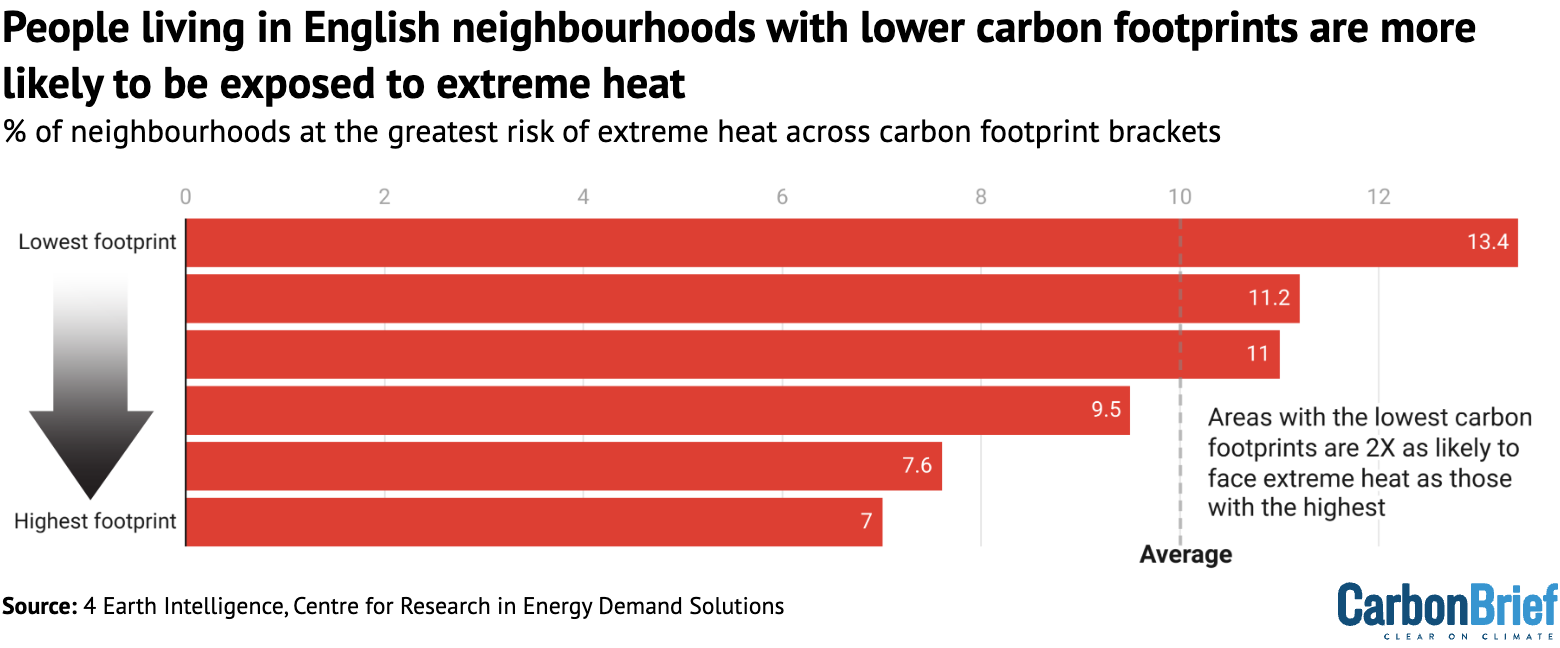
Neighbourhoods in England with lower carbon footprints are often in dense, urban areas, where people tend to be less reliant on cars and more likely to live in energy-efficient flats.
Areas with higher carbon footprints are commonly found in rural areas, where travelling by car can be a necessity due to limited public transport.
Also, particularly in south-east England, people in these rural neighbourhoods are often wealthier, meaning they spend more money on flights and other high-emitting luxuries.
Ethnicity and deprivation
Carbon Brief also analysed the heat threat facing deprived neighbourhoods in England and those that are home to more people of colour.
Information about how many people identify as black, Asian and other minority ethnicities in each neighbourhood is based on 2021 census data, via the Office for National Statistics.
As the chart below shows, there is a clear correlation between the number of people of colour living in a neighbourhood and the likelihood of it facing extreme heat during periods of hot weather.
The most ethnically diverse neighbourhoods – where roughly half or more of the population are people of colour – are 15 times more likely to have high heat hazard scores than the least ethnically diverse neighbourhoods, where almost everyone is white.
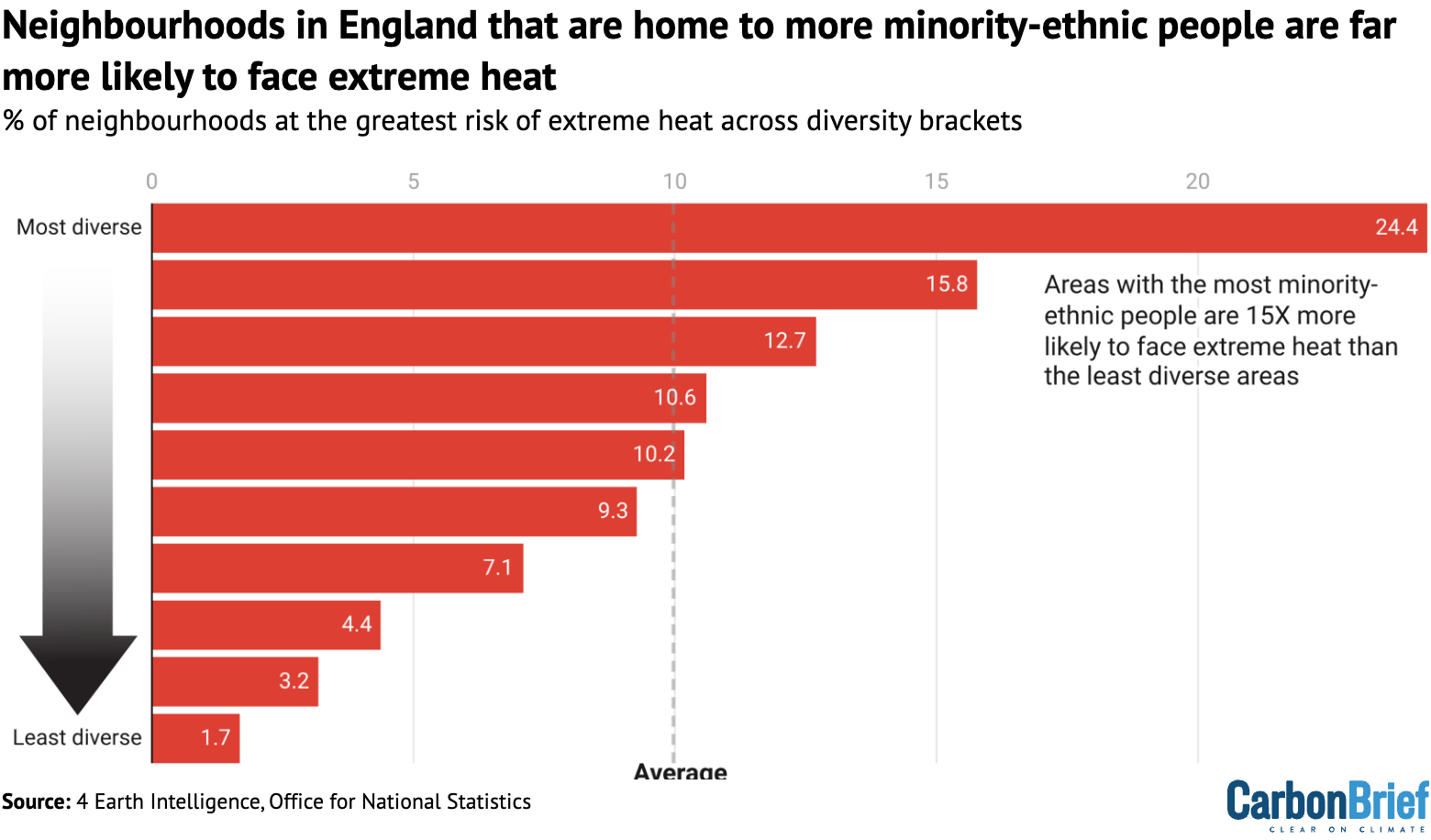
Among the most diverse areas are parts of Newham in east London, Saltley in Birmingham and Spinney Hills in Leicester, all of which are inner-city areas.
The least diverse neighbourhoods range from coastal parts of Redcar and Cleveland in North Yorkshire to the rural villages of south Somerset. None of England’s hottest 1% of neighbourhoods are in this bracket.
Additionally, Carbon Brief assessed the relationship between levels of poverty and heat risk, based on England’s indices of deprivation dataset. This covers several measures of deprivation, including income, employment and health.
People living in the most deprived English neighbourhoods are more than three times as likely to face high levels of heat hazard as those in the least deprived neighbourhoods, as shown in the figure below.
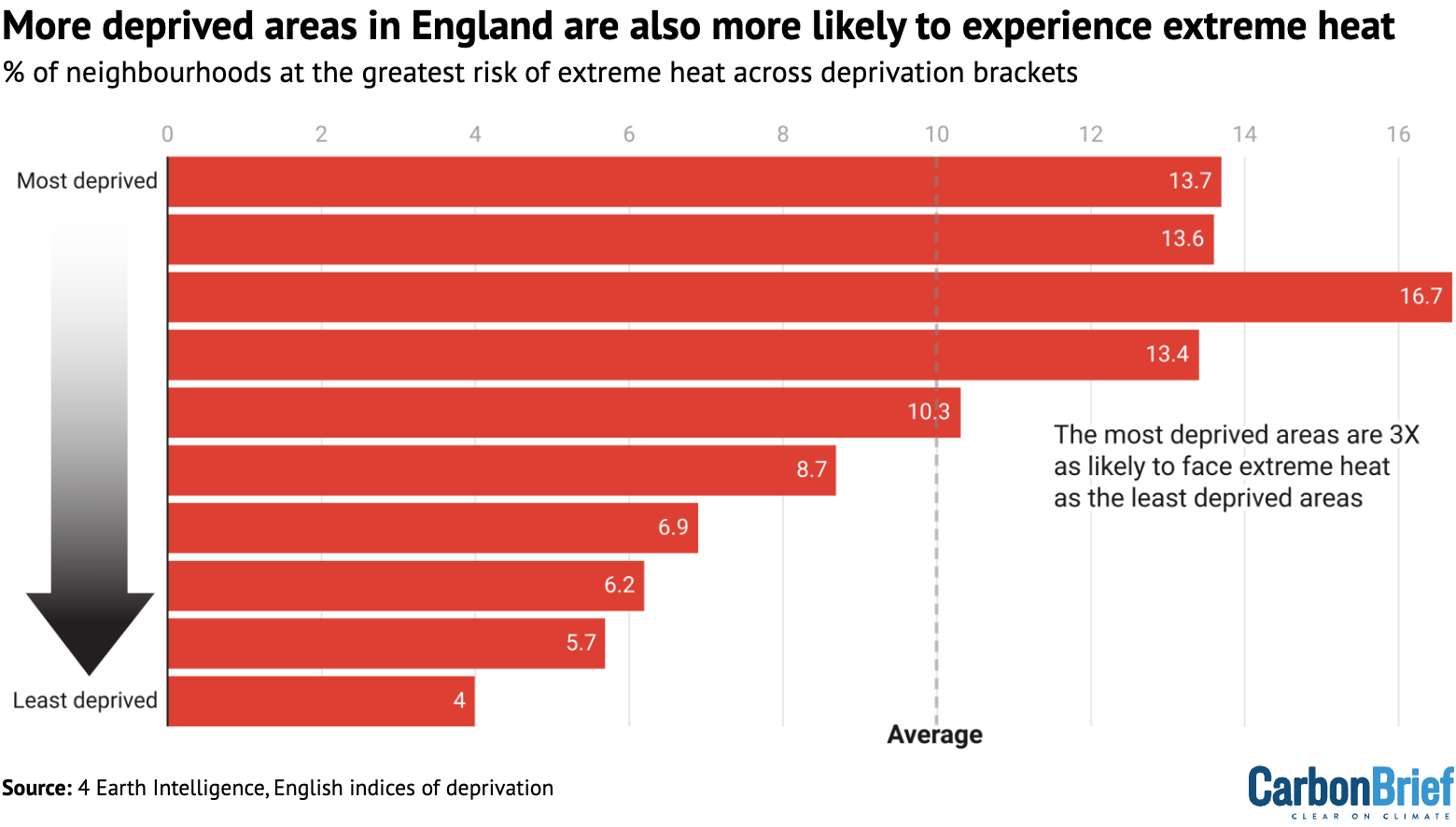
The correlation between poverty and extreme heat is less extreme than the one between heat exposure and ethnicity.
While many of England’s most deprived areas are in cities, they are also clustered in some rural and coastal areas – such as parts of Cornwall and Lincolnshire – which tend to be cooler.
Urban heat island
The key phenomenon captured by this analysis is the urban heat island effect. This describes how cities – and particularly areas with dense buildings, roads and stretches of concrete that absorb heat – tend to be hotter than the surrounding countryside.
Cities such as London, Manchester and Birmingham have reached temperatures up to 5C hotter than the surrounding areas in recent decades, due to this effect.
The diagram below shows how air flows circulate between rural and urban areas, forming “heat domes” over cities.
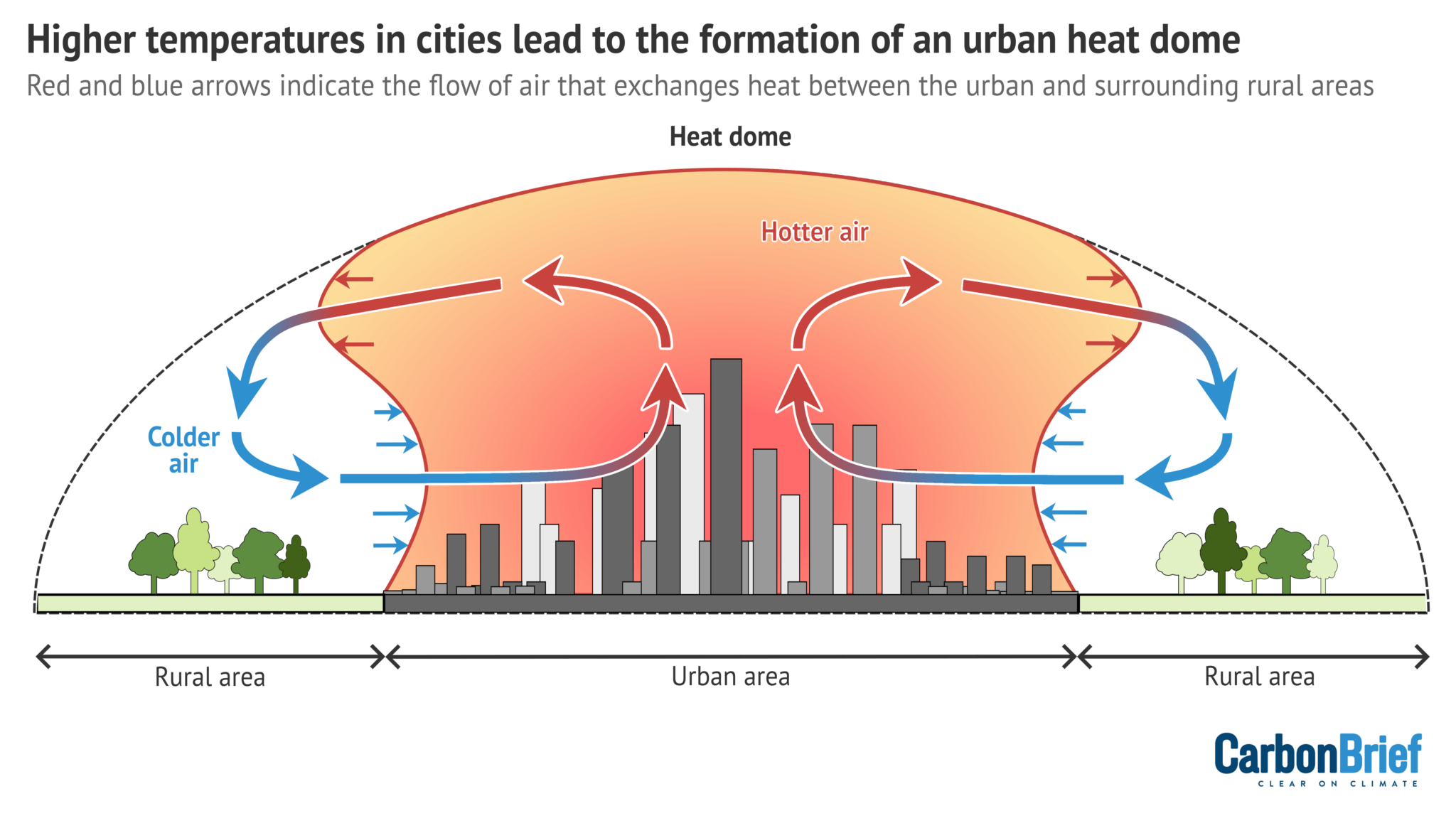
Inner-city areas in England are also home to many people facing high levels of deprivation, as well as large black and Asian communities. Many of these communities are therefore exposed to more dangerous temperatures due to the urban heat island effect.
Access to green spaces, even within cities, also influences exposure to the urban heat island effect. Research has shown how people in deprived areas and people of colour – particularly black people – are more likely to live in areas with less access to green spaces.
There is already extensive scientific literature that uses satellite data to demonstrate the urban heat island effect in cities and other locations.
A number of studies have also used this data to show how people of colour and those living in poverty are more exposed to extreme heat. Much of this research has come from the US, where historic housing inequalities have created stark patterns of segregation in many cities.
A project led by environmental policy researcher Dr Angel Hsu of the University of North Carolina-Chapel Hill shows how, globally, “cities are burdening lower-income populations with higher heat exposure”, as she tells Carbon Brief.
Given this, Hsu adds that “it’s not surprising to us to see similar disproportionate exposure patterns among UK neighbourhoods”.
Other researchers tell Carbon Brief that it is important to be wary of satellite data, as it does not precisely capture the air temperatures experienced in these neighbourhoods.
Dr Charles Simpson, who researches the health and economic impacts of climate change at University College London (UCL), notes:
“Satellite-measured surface temperature does not always correlate with the air temperature – what you are measuring includes a lot of road surfaces and rooftops. The air temperature is thought to be more directly relevant to people’s health and their cooling needs.”
Previous research has found that satellite data can therefore overestimate the urban heat island effect compared to data from weather stations.
These stations, however, are not widespread enough to allow comparisons with detailed neighbourhood data. They are particularly lacking in more deprived areas in England, potentially making measurements there less reliable.
Other scientists tell Carbon Brief that, in the absence of a comprehensive ground monitoring network, satellite measurements can serve as a stand-in to estimate heat exposure. Dr Chloe Brimicombe, an extreme-heat researcher based at the University of Graz, explains:
“Although it’s not a good indicator of perceived [temperature], it is a good indicator of what regions are most built up and have the environments that are most vulnerable to heat.”
‘Amplifying’ inequalities
There is a growing body of evidence gathered by activists, scientists and local governments around the UK revealing the unequal burden of climate change.
Dr Charles Ogunbode, an assistant professor of applied psychology at the University of Nottingham who specialises in how people experience climate change, tells Carbon Brief that this kind of data helps to clarify the links between climate change and inequalities:
“We can’t avoid dealing with the issue of social inequalities and climate change is just basically amplifying those things. It’s highlighting them, it’s revealing them. So whatever policies we put in place – be it in the health sector, be it in the climate sector – addressing those inequalities has to be an essential part of whatever those responses are.”
There are many factors influencing how people experience heat that are not captured in Carbon Brief’s analysis.
Previous work by researchers at the University of Manchester and Friends of the Earth has explored this issue, including an analysis of more than 40 indicators that could make neighbourhoods more “socially vulnerable” to heat.
This reveals similar outcomes, with people of colour and those contributing the least to climate change generally more vulnerable to its impacts.
One of the biggest factors that contributes to people’s exposure to heat extremes in the UK is the country’s housing stock, which is “not fit for the future”, according to the CCC.
UK homes have generally not been built for hotter conditions and poorer people are more likely to live in badly adapted housing. Those living in small homes, flats and social housing in England all “suffer significantly more overheating” during heatwaves, according to one study.
Dr Giorgos Petrou, a researcher in building physics modelling at UCL, tells Carbon Brief that it is also vital to consider whether households have the ability to adapt to climate change. “Amongst other factors, their capability will depend on their financial means and whether they own or rent their home,” he says.
Experts tell Carbon Brief that the government should act across its policy agenda to not only address extreme heat, but also support those who are most affected by it. This could involve expanding tree cover and renovating old social housing stock in at-risk communities.
Emma Howard Boyd, a former chair of the Environment Agency who also chaired the London Climate Resilience Review, tells Carbon Brief:
“I do think that with [the Labour] government focusing on house building and retrofit, this is a fantastic opportunity to get this right…For those communities that have had the least impact on the environment and climate change themselves.”
Methodology
This analysis collates several datasets that cover England at a neighbourhood level, with “neighbourhoods” defined as lower-layer super output areas (LSOAs). These are small statistical areas used by the UK government, covering populations of about 1,500-3,000 people. There are 33,755 LSOAs in England.
Data on vulnerability to heat comes from 4 Earth Intelligence (4EI), which analyses land surface temperature to generate “heat hazard” information at a 30m resolution. This detailed information has been converted into LSOAs by 4EI.
Heat hazard scores are calculated by 4EI, based on the likelihood that a given neighbourhood will experience high temperatures during hot weather, relative to the surrounding area.
Each score corresponds to a different percentile of English neighbourhoods. The bar below shows the percentage breakdown across all LSOAs in England.
The two hottest scores – those coloured in red – correspond to the 10% of English neighbourhoods that have higher heat hazard scores than the remaining 90%.

For simplicity, Carbon Brief’s analysis focuses on the red bars above, meaning neighbourhoods in either the top 90th-99th percentile or 99th percentile of heat hazard. (Neighbourhoods in the 90th-99th percentile have higher heat hazard scores than 90% of areas in England. Neighbourhoods in the 99th percentile have higher heat hazard scores than 99% of areas.)
It shows how these two scores are overrepresented in LSOAs that have lower carbon footprints, more diverse communities and higher levels of deprivation.
Carbon-footprint data is from the CREDS “place-based carbon calculator”, which estimates the average per-person carbon footprint for every LSOA in England. It accounts for emissions-producing activities ranging from electricity use to “consumption of goods and services”.
CREDS assigns the grades “A” to “F” (low carbon footprint to high carbon footprint) to neighbourhoods. Carbon Brief has based its carbon-footprint analysis on these grades.
LSOA-level data on black, Asian and other minority-ethnic populations comes from 2021 census data. English LSOAs were broken down into deciles, based on the percentage of the population that identified as non-white ethnicities.
The lowest decile covered the tenth of LSOAs with between 0 and 2% non-white minority-ethnic populations and the highest covered the tenth with more than 51%.
England’s indices of multiple deprivation dataset also includes LSOA-level information. It provides relative measures of deprivation for LSOAs in England, based on income, employment, education, health, crime, living environment and barriers to housing and services. Carbon Brief broke the LSOAs down into deciles based on the total deprivation scores, from the most deprived to the least deprived.
The post Analysis: England’s most ethnically diverse areas are 15 times more likely to face extreme heat appeared first on Carbon Brief.
Analysis: England’s most ethnically diverse areas are 15 times more likely to face extreme heat
-
Climate Change2 years ago
Spanish-language misinformation on renewable energy spreads online, report shows
-
Climate Change Videos2 years ago
The toxic gas flares fuelling Nigeria’s climate change – BBC News
-

 Greenhouse Gases1 year ago
Greenhouse Gases1 year ago嘉宾来稿:满足中国增长的用电需求 光伏加储能“比新建煤电更实惠”
-

 Climate Change1 year ago
Climate Change1 year ago嘉宾来稿:满足中国增长的用电需求 光伏加储能“比新建煤电更实惠”
-

 Carbon Footprint1 year ago
Carbon Footprint1 year agoUS SEC’s Climate Disclosure Rules Spur Renewed Interest in Carbon Credits
-
Climate Change2 years ago
Why airlines are perfect targets for anti-greenwashing legal action
-
Climate Change Videos2 years ago
The toxic gas flares fuelling Nigeria’s climate change – BBC News
-
Climate Change2 years ago
Some firms unaware of England’s new single-use plastic ban


